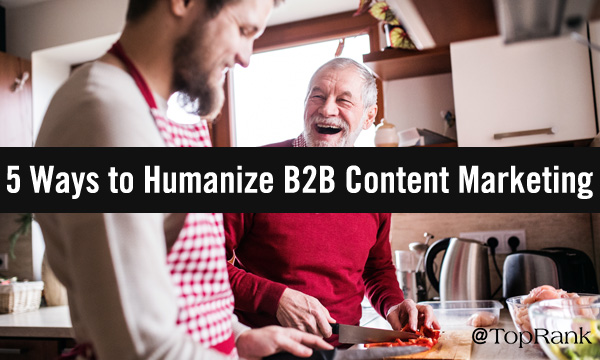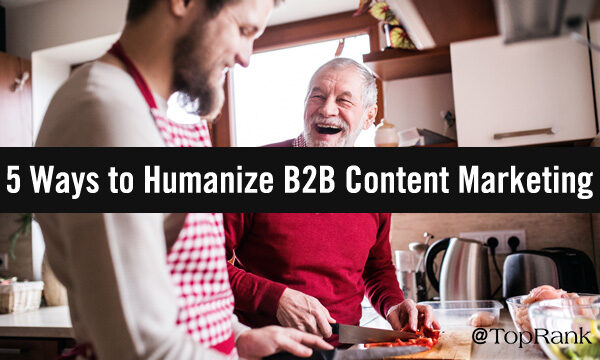
“You’ve really got to put yourself out there. Don’t be too stiff.”
“Be honest and sincere!”
“Be vulnerable and relatable… and it doesn’t hurt if you can make ‘em laugh.”
Is this advice for a middle-aged man trying online dating for the first time? Or is it advice for B2B marketers?
Given the proximity to Valentine’s Day, can’t it be both?
The point is, as good as this advice may be for marketers, it’s as vague as it is omnipresent. We talk about “person-to-person” marketing and “humanizing the brand.” But what does it really mean to humanize a brand?

Yes, these were the original Michelin Tire mascots.
In some cases, apparently, it means high-octane nightmare fuel. So, maybe don’t try and make an adorable mascot for your software-as-a-service solution.
Here are some better ways to “humanize” your B2B content.
5 Ways to Humanize B2B Content Marketing
It can be hard to bring out the humanity in B2B content, especially when your product is intangible. Not many folks feel a warm sense of empathy with a cloud-based data solution. You can’t take adorable Instagram photos of happy customers cuddling with your supply chain logistics platform. That just means that B2B content marketers have to be more creative than even our B2C counterparts.
Get Real about Personalization
We all know there’s a fine line between being personal and being overly familiar. But we have to find that sweet spot between, “Hi, [firstname]” and “Hey Bob Johnson, 42, who ate a hamburger for lunch, how was your recent prostate exam?”
For B2B marketers, think more about smarter segmentation and less about personalizing on the individual level. As Ardath Albee (persona expert extraordinaire) puts it, “In B2B, we don’t need to know their shoe size and we don’t need to talk about their gender. We don’t need to know they live in the suburbs and have a wife, two kids, and a dog, and they drive a red Corvette.”
What we do need to know are the general challenges and aspirations people with a specific job title in a specific industry might have in common. Then we can customize content to suit their job-related needs — even the ones that don’t relate directly to the product.
Find the Emotional Core
It’s hard to imagine someone getting emotional about a B2B product — jumping up and down with excitement, wiping away tears, or eagerly unboxing the latest model. For B2C, the product itself might inspire these emotions. For B2B, the emotion comes in at a different angle.
It’s not about the solution itself — the emotion comes from what the solution can do. For example, the product may be a software solution that enables automation. The emotion comes from an employee who is able to finally leave work on time to be at home with their family.
Or it’s the thrill of earning a promotion with the help of a new analytics tool. Or the intertwined hope and anxiety of starting your own business, using a web hosting platform to launch your first site.
“Find the emotional stories that your solution makes possible, and make them the star of your content.” @Nitewrites Share on XDesign a Content Experience
We know that valuable, best-answer content is the minimum for reaching an audience. That’s the new table stakes.
But B2B marketers are frequently accustomed to no-frills, straightforward presentation for all that thoughtful content. It’s called a white paper, after all, not a plaid paper. But when we’re thoughtful about the content experience, we can show off the brand’s creativity and personality, while at the same time showing respect for the audience.
Think about turning a long-scrolling asset into a beautiful and unique interactive experience. Or that series of interview posts into a long-form video series. Content experience is all about telling your audience, “Hey, we know that people need to be entertained. We’re people, too! So we made this not only useful, but also beautiful to look at and fun to play around with.”
Earn Trust By Asking for Help
I know, it’s tempting to present your brand as the alpha and omega, be-all and end-all source of all knowledge. If your wisdom isn’t absolute, why would people trust you as an authority? But the truth is, humility builds credibility more than the most dazzling display of knowledge does.
It’s called the Ben Franklin effect: When you help someone, you tend to like them — even more than if they helped you. So, give your audience an opportunity to help you out.
Ask questions that you genuinely want to hear answers to. Engage with their responses, ask more, let their expertise drive an ongoing conversation. This type of engagement accomplishes multiple goals:
- Your audience gets to show off their expertise
- Even those who don’t participate can now see themselves in your content
- Your brand becomes relatable and interactive
- You might actually learn something that can drive your next big idea
Involve More Actual Humans in Content
Brands don’t create content; people do. But frequently we hide the human content creators behind the monolith of the brand. If we’re trying to connect with people on a personal level, we’ve got to let the people shine through.
That means giving employees and executives alike a voice in your content. But don’t stop there: Feature your customers and prospects, too.
Think about including influencers in your content as well, and not just as a one-off. Yet another of the endless perks of influencer marketing is that humanization of your brand. Influencers add credibility and prestige to content, but don’t overlook how they add personality, humor, and humanity, too.
Embrace Your Human Side
As a creative writer with a weird sense of humor, I’m incredibly lucky to be in marketing right now. Just a decade ago, B2B marketing would have driven me insane by my third dry-as-dust eBook. There’s only so many times you can write about “utilizing and leveraging synergy” in third-person passive voice before the gears start to slip.
Fortunately, B2B content marketing has finally caught up with B2C in terms of creativity, emotional import, and essential humanity. We have “permission” to do it right — so what are we waiting for?
Humanize your brand with some great influencer content this year: Here are 25 ideas to get you started.



